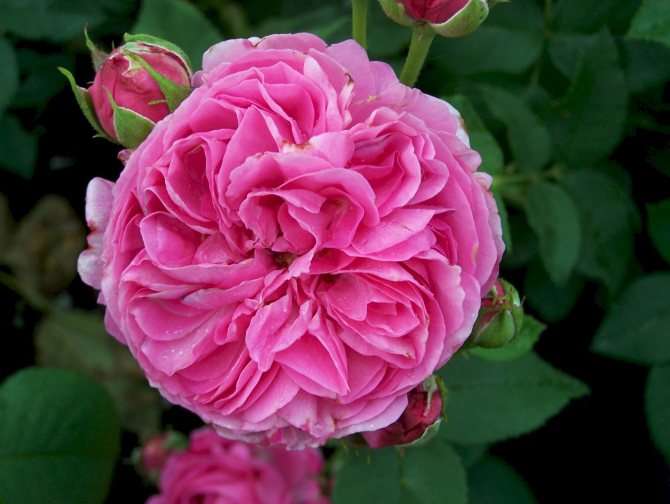The rose has long become an indispensable element of the decor of every garden. Even the most picky and capricious flower lover will find in the variety of cultivars what he will like. This is not surprising, because today there are, according to various sources, from 25 to 50 thousand varieties and hybrids. Perhaps no other flower is distinguished by such a variety. What unites roses is that they are all perennial plants, they bloom beautifully and for a long time, with proper care they can remain on the site for more than two decades. And their phytoncides have a beneficial effect on the physical and mental health of a person.
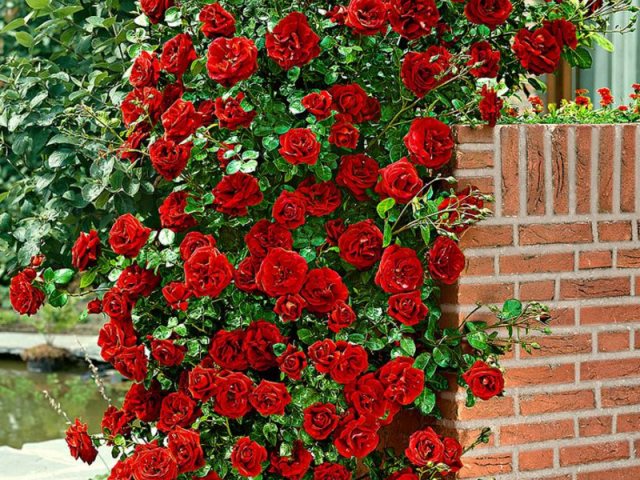
Roses are babies, the size of which does not exceed 20 cm, and the flower is 1.5 cm, and they can have shoots reaching 6 meters in length, the diameter of the flower in some varieties is 18 cm.They can be grown in the form of a bush or a standard tree from 30 up to 150 cm tall, ground cover or climbing plant. Today our heroine will be a climbing rose, the popularity of which either fades or flares up with renewed vigor. To date, so many beautiful new varieties have been created that it is worth getting to know it better even for those who did not show interest in this variety before. We present to your attention the best varieties of climbing roses with photos.
Description of the plant
How and when to plant a climbing rose should be considered before starting to grow a flower on your site. You need to understand in what conditions it will feel good and will thank its owners with lush flowering.


You need to understand what kind of plant it is. This species has many climbing roses. They differ in some characteristics. So, the rambler rose belongs to the first category. It is a climbing plant that has long, arched or creeping branches. Their length reaches 5 m and more. Plants in this group have small leaves. Semi-double simple flowers have a weak aroma, reach 2.5 cm in diameter. They are located along the entire length of the branches. Rosa rambler blooms in the first half of summer for about a month. If you are choosing the best varieties of climbing roses that can withstand even severe frosts (under cover), give preference to this group of plants.
As a result of the hard work of breeders, varieties of roses of the group of climbers were bred. These are climbing plants, the shoots of which reach a length of 4 m. These are large-flowered climbing roses. Their buds reach a diameter of 4 cm and more. Many plant representatives of this subspecies bloom twice a year. Almost all varieties of this group are winter-hardy climbing roses that bloom all summer. At the same time, they are resistant to pests and diseases, they feel good in the conditions of the domestic climate.
The third group includes klaimings. They do well in the southern regions. These are plants with large flowers ranging in diameter from 4 to 11 cm. They grow singly or form a small group of inflorescences. Many claimings bloom twice a season. These are roses that do not tolerate severe frosts.
Climbing roses and their uses
Climbing roses are garden varieties and some types of rose hips that have long, flexible shoots.This is what determines the area of their application in landscape design. In nature, there are no such types of roses that twine around the support like vines, but a person can give them a vertical position with a garter or located in the immediate vicinity of the supports.
It is vertical gardening that is the area where climbing roses can show their beauty to the fullest. They are planted near pergolas, gazebos, arches or special lattices, with the help of scraps and a garter, they direct the whips in the right direction. Thus, they form truly magnificent blooming small architectural forms designed to decorate our site, and often carrying utilitarian functions. With a wall of blooming roses, we can well protect a gazebo or a resting place from the wind, cover up unsightly outbuildings, which in a small area simply cannot be taken away from the living area. With the help of trellises, pergolas, flowering arches, we can even visually enlarge a small area, and divide a large one into zones.


Many varieties of climbing roses will look great as a solitary focal plant if properly formed around a support in the form of a flowering column or a sprawling tall weeping bush. It is they who serve as a fertile material for creating standard roses.
Reproduction
Climbing roses in the garden are propagated in different ways. Several techniques can be used. They involve the cultivation of these plants by seeds, layering, cuttings, grafting. They differ in a number of features. The easiest way is to propagate by layering. But even when using cuttings, difficulties usually arise.
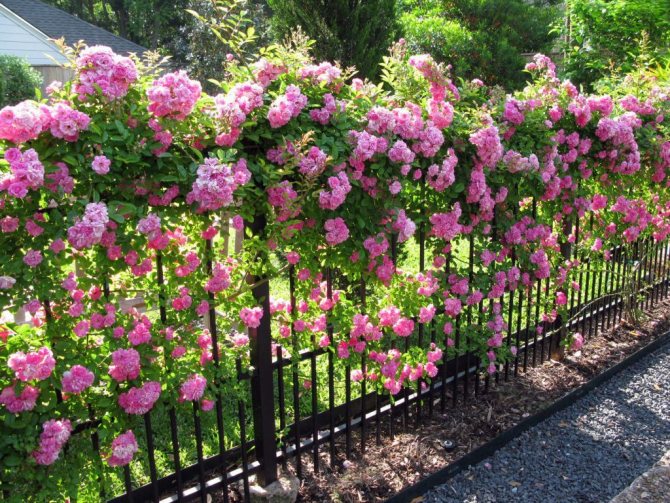

If you decide to plant roses with seeds, then you need to purchase seed in garden stores. If you pick it from the plants yourself, they will not retain the traits of their variety. Therefore, it is difficult to predict what this plant will look like. You can, of course, experiment, if it is not important for you to grow a rose with exactly the same characteristics as a year ago. But it will be more expedient to purchase seeds.
A climbing rose is easiest to propagate by layering. An escape must be chosen in the spring. It is incised below the level of the kidneys. Next, the stem is placed in the prepared hole. It should be about 10-15 cm wide. The hole should be the same depth. A layer of humus, sprinkled with soil, is laid down. The layering must be fixed in several places. It is covered with soil. The top of the layer must remain above the surface. The next year, the cuttings are separated from the mother bush. It can be transplanted to a place of your choice on the site.
Another easy way is to graft roses. This can be done at the root of the rose hip. This will require a cultivated rose peephole. Budding takes place at the end of July or August. It is necessary to water the rosehip abundantly with water before carrying out this procedure. On the root collar you need to make an incision in the form of the letter "T". You need to pry on the bark and pull it back a little from the shoot.
From the stem of the rose, you need to cut off the peephole and the adjacent bark with a layer of wood. A peephole is tightly inserted into the prepared incision. This place is tightly fixed using the budding material. Above the grafting site (about 5 cm), the rose hips are spud. The dressing is loosened after 15 days. The film is shot the very next spring.
Climbing rose constantly blooming: the best varieties
These include the following varieties:
- Avila Palace;
- Iceberg - floribunda that looks spectacular due to chic long branches;
- Faya Lobby is climbing;
- Prairie Joy - Canadian-bred roses;
- Coral sunset.
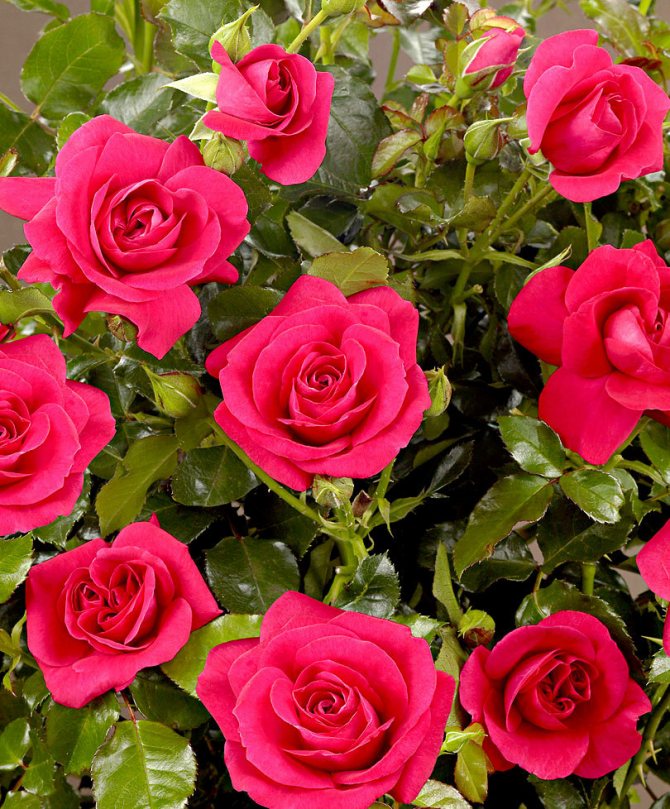

The abundance of varieties allows each grower to choose the variety that will look best on the site.
Seeds
Thinking about planting climbing roses outdoors? Then you should familiarize yourself with the information on the ways in which this plant is propagated. If you want to get it from seeds, you need to buy planting material at the store. They are laid out in a sieve, which is lowered into a bowl. You need to pour hydrogen peroxide into it. This allows the seeds to be disinfected. During stratification, the likelihood of mold growth will be much lower.
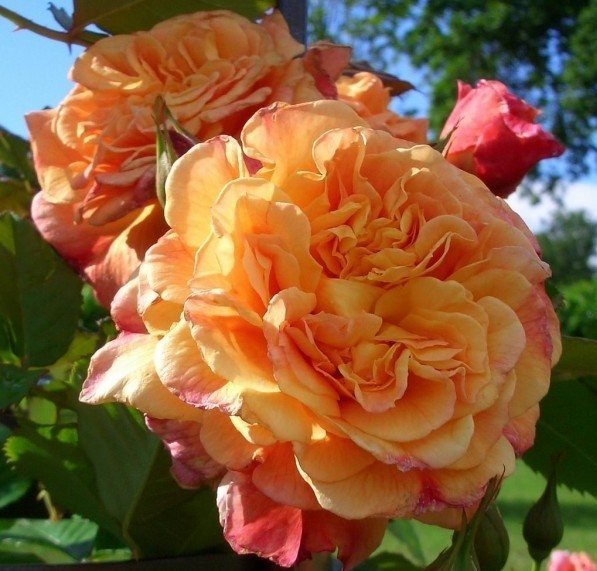

After that, you need to moisten a cotton pad with hydrogen peroxide. Prepared seeds are spread on it. They are covered with a second, equally soaked disc. Each pair must be placed in a separate plastic bag. You need to write the name of the variety and the date on them. You need to transfer all the packages to a separate container and place it in the vegetable compartment in the refrigerator.
Check the condition of the seeds. If you notice mold, spray the seed again with hydrogen peroxide. Use new cotton pads for this.
In one and a half or even two months, the seeds will germinate. They need to be transferred to individual peat tablets or miniature pots. The surface should be covered with a small layer of perlite. Seedlings should be in a lighted place for 10 hours a day. After two months, the first buds will appear on the plants. A month later, they will bloom. Climbing rose seedlings need proper watering. The soil is moistened as it dries.
When to plant a climbing rose grown from seeds? This must be done in the spring. Consider your climate. The warmer it is, the earlier you can do it.
Types of climbing roses
For landscaping arches, pergolas, gazebos, the formation of living walls, varieties of roses are used that need support. These include:
The waters are here and you need to make an initial choice. Since these two groups differ in some of their properties.
Ramblers are truly climbing roses with rather flexible shoots that are easy to direct along the support. Blossom once. In addition, they are also easy to lay on the soil in the fall under a shelter. They require minimal pruning, more precisely, only sanitary, as they bloom mainly on the shoots of previous seasons. But that is why they need protection for the winter period, even despite the high estimates of the winter hardiness of the variety. It is important to keep young lashes for flowering in the coming season. It will be enough to make a light air-dry shelter. If they are left to winter, relying only on their own strength, then the shoots that have frozen over the winter will have to be removed and in this case the flowering will be poor, only on the surviving branches. Today, there are young rambler varieties that bloom repeatedly.
Cuttings
Even an inexperienced gardener can grow a climbing rose from cuttings. This is the easiest way. The result in this case is almost one hundred percent. When to plant a climbing rose that is bred by cuttings? It depends on the time when you prepared the shoots. Usually this procedure is carried out from mid-June to the first week of August.
The segment you choose for this purpose must have at least two internodes. A lower cut is made under the kidney. It should be at a 45 ° slope. The upper cut must be straight. It should go as far from the kidney as possible.
The lower leaves must be removed from the cut cuttings. The top sheets are shortened by half. You need a pot or other container with a substrate of sand mixed with soil. A stalk is stuck into it to a depth of about 1 cm. The shoot is covered with a plastic bottle or jar. The container is placed in a lighted place. It is necessary to protect the plant from direct sunlight.
The soil in the pot is watered without removing the jar. If the variety you have chosen does not root well, the cut must be treated with a root-forming compound before planting the cutting. However, in most cases this is not required.
So that your work is not in vain, you need to know how to plant climbing roses. In this matter, they are quite capricious.
Roses by V. Cordes
These are roses of continuous flowering. The varieties cultivated by V. Cordes are an impressive group of roses, which are distinguished by resistance to diseases, unfavorable climatic conditions, increased immunity. They can be climbing, standard, hybrid tea, ground cover, park.
Rosa Izdastes (Easy Does It), namely her Cordes considered the pinnacle of his breeding work, belongs to the floribunda and changes color from red to light pink. Surprisingly, at the very peak of its flowering, when the bud is fully opened, the flower takes on an orange hue. The description of this metamorphosis is difficult to convey in words.
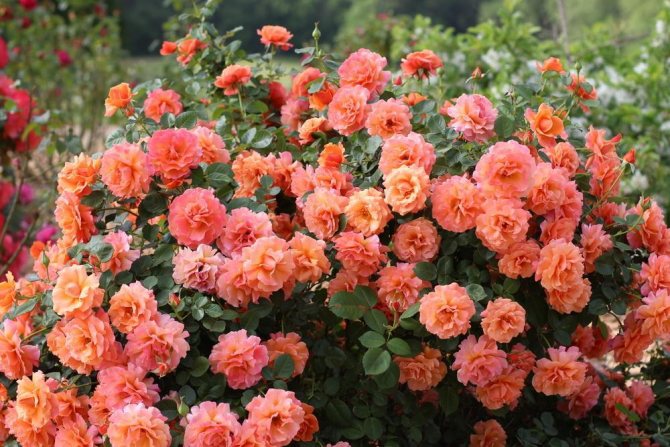

Rose Izdastes
These beautiful flowers can be very different, but they have one thing in common: they bloom for a long time and abundantly, delighting gardeners with their appearance. Plants have concentrated in themselves the best features of the royal flower that you can imagine.
Landing rules
There are several guidelines for planting climbing roses. They must be taken into account before starting to grow this plant. The fact is that all roses are quite capricious. Climbing varieties are no exception. Therefore, you need to organize the process of growing them correctly. You need to choose the right site.
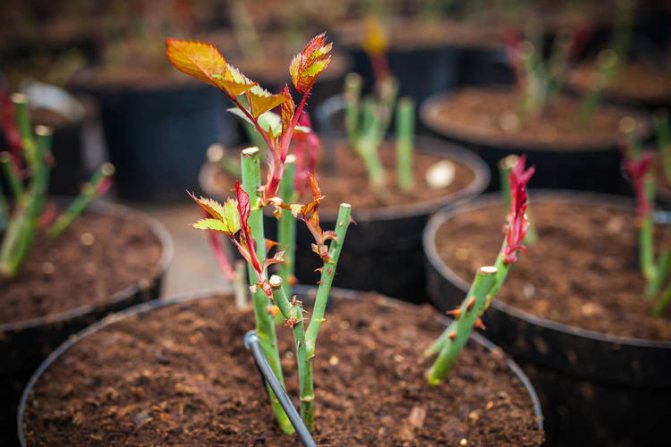

Climbing roses need plenty of bright light. But it should hit the plant in the morning. In this case, the dew on the leaves will dry out quickly. This will significantly reduce the likelihood of developing fungal diseases.
But it is also worth considering that when the sun is at its zenith, it can cause burns on the leaves and buds. Therefore, you need to consider appropriate protection at noon for this plant.
Another adverse event that can negatively affect the health and well-being of roses is draft and wind. The plant must be protected from this. Therefore, consider a fencing system. Do not plant a climbing rose in the corners of a building. Drafts often appear here.
When choosing where it is better to plant a climbing rose, it should be noted that the best place for it will be the south side of the house. At the same time, it does not require much space. For a rose, you will need to select an area about 0.5 m wide.At the same time, the closest object (wall or other plant) should be at least 50-100 cm away from it.
It is also important to pay attention to the soil in which the rose will grow. It should be permeable soil, where groundwater does not come close to the surface. It is best if the site is sloped here. If the groundwater is close enough, artificial elevations are made so that moisture does not stagnate in the roots. In some cases, the roots go up to 2 m deep.
Climbing roses grow best on loam. Too light or heavy soils will need to be adapted to the needs of this plant (sand is added to clay soils, and vice versa). Humus and phosphorus fertilizer are also added to the soil. It is recommended to prepare a site for growing roses six months before the start of the season.
Requirements for the composition of the soil
Almost all types of these flowers prefer loamy and permeable soil. Climbing roses have a developed root system, which often deepens by more than 1.5 m into the bowels of the earth. Therefore, if there is groundwater nearby, then it is recommended to plant bushes on a hill. If the soil is too clayey or, on the contrary, sandy, then a soil adaptation is required. The clay composition is diluted with bone meal, humus, humus and sand, and black soil is added to light soils.
Planting in autumn
The climbing rose can be planted outdoors in autumn (late September to mid-October) or in spring (April to May). You need to choose the right or prepare your own planting material. There are usually no problems with the purchase of seeds.If you buy seedlings, carefully look that it is a grafted plant on the root of a rose hip or a self-rooted rose. The features of plant care depend on this.
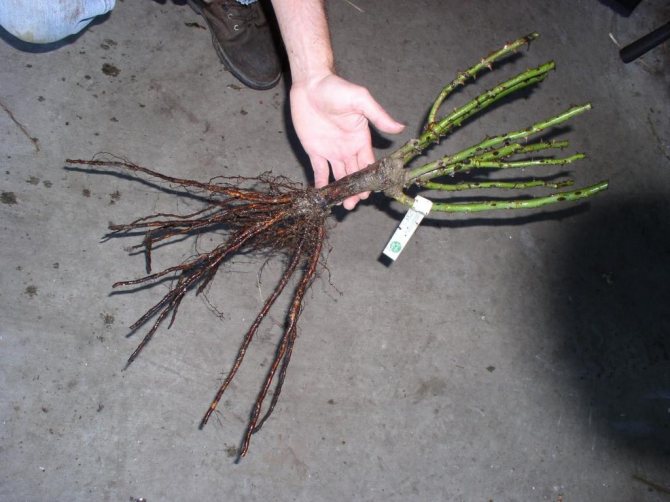

So, the grafted rose must be planted to such a depth that the place of the scion is 10 cm below the surface of the earth. Otherwise, the plant will deplete and die. If there are kidneys below the vaccination site, they are removed. Otherwise, rosehip shoots may develop from them.
If you are planting a plant that is not grafted, before carrying out this work, you need to perform some manipulations before planting. To do this, you need to soak the roots in water, and then remove all the leaves from the plant, cut off the broken, immature shoots with a pruner. Sprinkle the slices with charcoal. The roots and the ground part must be shortened to 30 cm. With the help of a solution of copper sulfate, the seedlings must be disinfected.
Planting holes are usually 50 x 50 cm in size, but you need to focus on the size of the roots. Leave a distance of about a meter between the plants. The fertile soil layer, removed when creating a depression, is mixed with manure. A little of this mixture is poured onto the bottom, watering the hole with a sufficient amount of water. This procedure is performed 2 days before planting.
Treat the roots with an antiseptic solution immediately before planting (for 0.5 liters of water you need 3 tablets of "Phosphorobacterin", 1 tablet of "Heteroauxin"), after mixing it with 9.5 liters of clay talker.
A hill of soil with manure is poured at the bottom of the hole. Saplings are placed on it. The roots should be treated with a roaster. They are sprinkled with soil, and then the soil is well tamped.
Cultural pests and control
Frequent uninvited guests of roses are spider mites and aphids. To combat these pests, special preparations will help:
- Actellik;
- Decis;
- Opercode;
- Spark;
- Fitoverm;
- Intavir;
- Aktara.
Insect pests are not always the cause of wilting or death of rose bushes. The plant and diseases are affected:
- powdery mildew;
- black spot;
- coniotirium;
- gray rot, etc.
Features of mallow and care for it, types and rules for their cultivation
To begin with, you should correctly diagnose the disease, and then immediately start treating the plantings. Although in the case of bacterial cancer, treatment will not bring any good, and it will be necessary to get rid of the bush by burning it.
Planting in spring
Climbing roses are rarely planted in the spring. Plants that were planted during this period lag behind in their development. Therefore, it is still better to leave this activity for the autumn period. But if you decide to land now, you need to pay attention to all the nuances of this procedure.
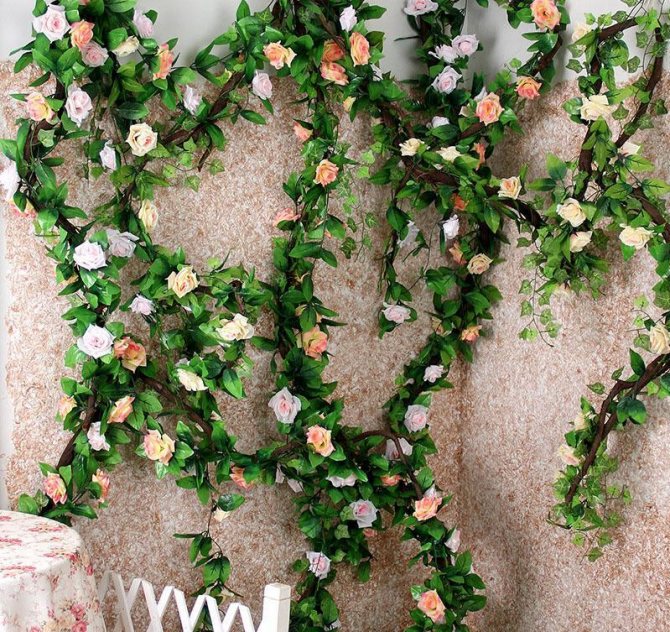

So, the plants need to be shortened to 15-20 cm. The roots should be no longer than 30 cm. You need to choose the right companion plants. What to plant next to a climbing rose? They will be effectively complemented, for example, by clematis or green thuja. You can complement the composition with irises, bells or carnations. These plants will not embarrass a capricious rose.
After planting in open ground, seedlings are watered abundantly. They need to be hilled high, and then covered with foil. In greenhouse conditions, the plant will grow faster. The film must be lifted for a few minutes every day. The airing time is gradually increased. When stable warm weather is established, the site is mulched, and the shelter is removed.
Reviews and comments
- Lera Incredibly beautiful roses, I used them to decorate the veranda. In summer they are excellently protected from the sun. The rose blooms for a long time, while it smells very much. These flowers are completely unpretentious to care for.
Nina I really like these climbing roses. But I myself have never grown them, only at my friends in the country I saw. Now I have bought a dacha and will grow my favorite flowers there. Now I study all the subtleties of planting and leaving, so as not to ruin.
Care rules
Almost any climbing rose requires special attention. Outdoor care for this crop implies timely watering of the plant. It is necessary to apply top dressing to the soil, periodically cut off the shoots, and also take appropriate actions in the fight against diseases.
Climbing roses grow next to the support. It is worth noting that this plant is very drought tolerant. It does not need abundant, frequent watering. Water the roses once a week. If the weather is humid, you can do this even less often. It is better to fill the bush less, but do it more often. The roots do not like stagnant moisture. Because of this, the rose may hurt. Each bush requires no more than 2 buckets of water.
To retain moisture in the soil, a few days after watering, the soil around is loosened to a depth of about 6 cm. It is best to mulch the soil surface near the bush. For this, peat is used.
Young bushes are not fed until August. At the beginning of autumn, potash fertilizers can be applied to the soil. This will prepare the plant for winter. If the plant is more than one year old, you need to apply mineral and organic fertilizers in turn. In the third year of life, roses only need organic fertilizing. During the growing season, fertilizers must be applied to the soil at least 5 times.
Transplanting bushes
It is known that it is not always possible to guess with a suitable place for rose bushes, but transplanting adult bushes is often not advised, if only for salvation. Autumn is a good time for transplanting (the last days of September - early October). These deadlines must be met in order to preserve the plant and give it time for full rooting.
When transplanting from one place to another in spring, you should choose an early time, while the buds on the shoots have not yet had time to awaken.
When the time for transplanting has come (in the fall), the lashes should be removed from the support, the bushes should be widely dug around the root, then the plant should be removed. Trim all torn hairy roots with pruning shears. In a new place, straighten the root system, cover it with fertile soil, tamp the soil and water generously. A few days after transplanting, you should additionally spud the bushes, and then repeat this procedure before winter.
When transplanting Rambler, young shoots are left intact. One has only to pinch the tops of the shoots in advance, back in August, to accelerate their lignification. Two-year-old shoots are cut off completely. The varieties of Claymers and Climings are transplanted according to a similar scheme, only long shoots in their case should be shortened by 50%.
Support
Support for a climbing rose is required. Their diversity is amazing. For these purposes, both a specially acquired structure and improvised items are suitable. For example, it can be an old tree on the site, a hedge. You can order a support for a climbing rose of various shapes and designs. This can be an arch, a lattice, which will be made of metal, wood or plastic. The latter is the preferred option. Polymers are resistant to adverse environmental influences.
However, you should not choose a gray, faceless wall as a support. Even these beautiful plants will not be able to ennoble the look of an old utility shed for tools. It is better to purchase a support for them separately.
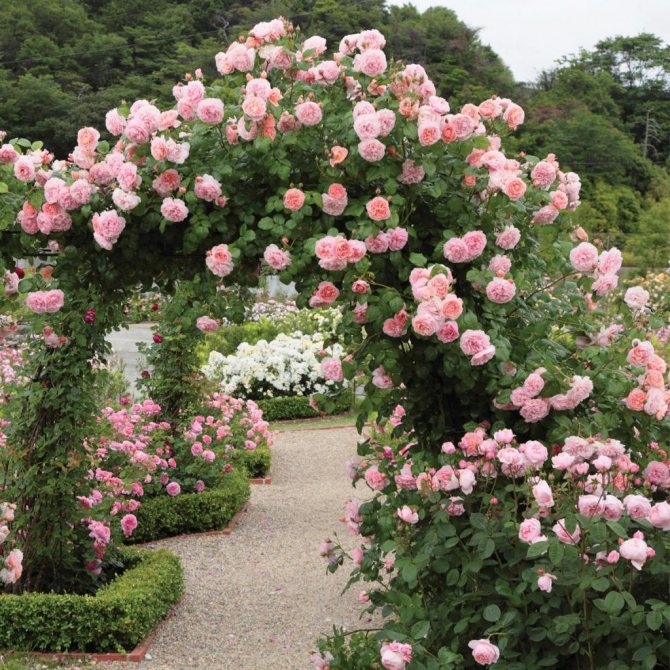

It is worth noting that when the branches are fixed in a horizontal plane, flowers will appear along the entire length of the shoots. If you fix them in an upright position, the buds will appear only at the top of them.
To secure the branches, you need to use a twine made of polymer materials. Never use wire for this purpose, even if wrapped in cloth or paper. The support structure must be at least 50 cm away from the rose.
Preparing for winter
Shelter should be started at the onset of autumn weather at -5 C. At an earlier date, shelter should not be carried out, so as not to provoke a root debate.Also, the plant must get used to the cold snap and develop a slight immunity to it.
The process of hiding roses is as follows:
- remove the whips of the flower from the support;
- remove dry foliage, too small shoots and shoots;
- tie all the whips together with twine;
- organize a substrate for lashes from dry grass, spruce branches, etc. and lay a "package" on them;
- having fixed the lashes on the substrate, they should also be covered with dry grass on top and sprinkled with soil;
- with the final layer, it is necessary to protect the covered roses from precipitation, therefore roofing material, slate, lutrasil, etc. can be used.
On thaw days, it is sometimes recommended to remove roofing material or lutrasil from roses to give the plant some fresh air. And it will be possible to fully disclose them with the onset of warm days.
Pruning
Novice gardeners wonder if climbing roses are pruned. This procedure helps to form a correct, beautiful crown. It also stimulates abundant flowering, which will be observed throughout the entire height of the bush. Therefore, if you want to give the rose a special decorative effect, be sure to prune it.
Also, this procedure allows you to maintain an almost continuous flowering process. Particular attention should be paid to vegetative shoots. Flowering occurs mainly on the branches of the previous year. Pruning should be done in the fall and spring. During the growing season, dead shoots must be removed from the bush. The ends of the branches are trimmed to a strong outer bud.
If a rose blooms once a season, has basal shoots on which buds have appeared this year, they must be cut out after the end of the growing season. The next year, flowering will be observed on the recovery shoots. They are formed from 3 to 10 pieces. Basal shoots are cut at the root. This procedure is carried out in the fall.
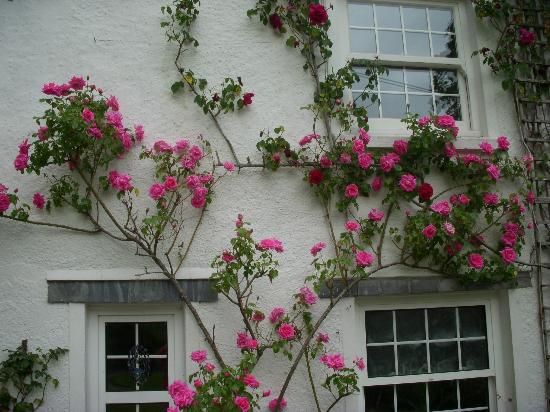

If a rose blooms twice a season, buds appear on its main shoots within 3 years. By the fifth year, this process is weakening. Therefore, in early spring, they are cut to the ground. This procedure is carried out in the fourth year of the plant's life.
What is winter hardiness?
Winter hardiness is the ability of plants to withstand impacts in their habitat from late autumn to early spring. Such influences are a sharp temperature drop, sunburn, winter dryness, return frost, damping, soaking, and others. Winter hardiness is considered a broad concept, which includes, in addition to surviving in low temperatures, and other things.
Freezing is the most common cause of plant death in winter. Severe frosts convert water in the cells and intercellular space of plants into ice. Crops are affected by an ice crust during a thaw. The ice shell prevents plant organisms from receiving oxygen. Cellular air saturation deteriorates. Stagnation of water causes soaking of crops and damage to them by frost in the future.
The process of hardening in plants in autumn and winter develops its winter hardiness.
Popular varieties
- Ave Maria grows in medium-sized flowers with a strong aroma. Shoots are located on a climbing bush, which blooms quite abundantly and intermittently. The cost ranges from 300 to 500 rubles.
- Aelita famous for its large flowers, the diameter of which reaches 8 - 10 cm. Petals to the touch are double-type in white. The cost is no more than 500 rubles.
- Berlin differs from all other varieties in buds that grow in an elongated-pointed shape. The flowers have a faint, modest, fragrant aroma. Leathery leaves are dark green in color. The cost is 350 - 390 rubles.
- Hamburg grows with pointed buds. The petals are delicate crimson and large enough. The aroma is faint. The cost of this variety reaches 500 rubles or more.
- Mermaid has large flowers, the diameter of which reaches 9 cm. Petals are open, yellowish. The aroma is very pleasant and fragrant. The cost does not exceed 500 rubles.
- Paquet famous for its pure white petals.Blooms very intensely throughout the summer. The cost of this variety starts from 500 rubles or more.
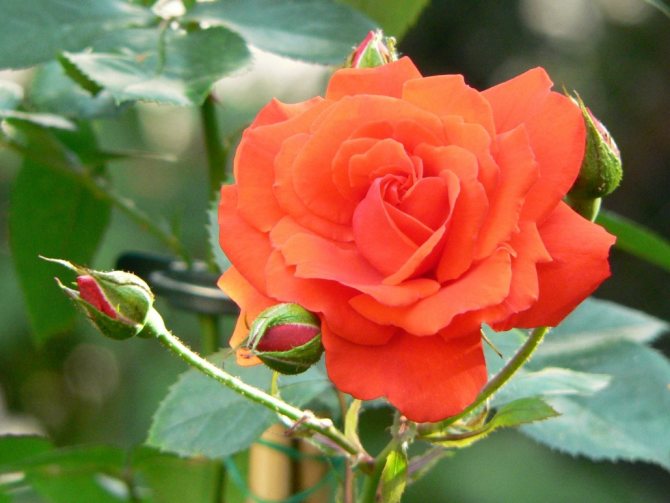

Ave Maria


Aelita


Berlin


Hamburg Mermaid Paket
Pierre de Ronsard
A very successful imitation of old varieties. The bush is compact, the length of the shoots is 1.5-3 m. There are almost no thorns. The flowers are large (10–12 cm), almost odorless, cannot stand rain, do not fade in the sun. Whether the buds open to the end depends on how warm it is in summer. The petals shimmer with shades of ivory, mother-of-pearl, cream, the edge is bordered with pale pink. Flowers are mostly solitary, rarely collected in three. The variety is re-flowering. The bush grows slowly.
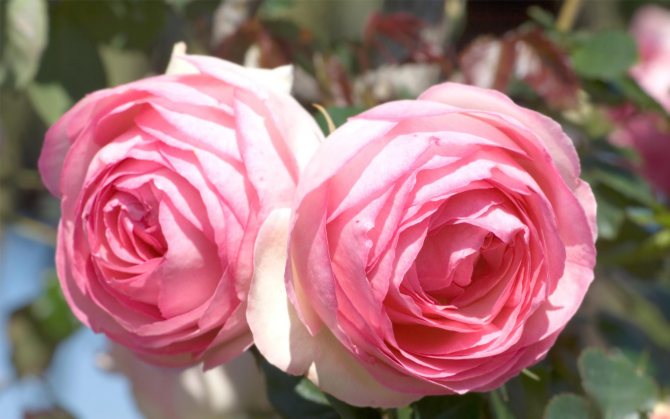

Rose Pierre de Ronsard was named in honor of the Renaissance poet known mainly in France, therefore in other countries it is found under the name "Paradise rose" (Eden Rose)
Tips for florists for choosing a variety
- In fact, each grower chooses a variety based on wishes and goals. If the goal is to create a decorative look in the country or near the house, then it is climbing rambler roses that can be an excellent solution.
- It is best to choose several different types of Rambler roses. All species bloom in their own way and with their own characteristics. Most importantly, each species grows in a different period of summer and for a different time. By combining several types of Rambler roses, you can get an excellent composition that will delight you with its floral mix.
- Such a "mixture" can be placed near the gate of the house oron the contrary, make an arch of roses.
- Someone will prefer Climing roses. The choice is behind every grower. Each variety and species is beautiful in its own way and has its own advantages, such as, for example, resistance to frost, diseases and harmful insects.
Design Tips
Would you like to bring chic notes to your garden with climbing roses, but don't know how to apply them? Here are some places where they will look good:
- walls of buildings;
- fences;
- arches;
- straight frame (you get the illusion of a living fence);
- curly frame;
- corridor.
Arch decoration Beautiful bush for decorating the lawn in front of the house Decorating with climbing roses
Combinations of two varieties of roses look unusually attractive. The table shows the most profitable solutions.
| "Tenderness" | Snow Goose + Indigoletta |
| "Classic" | Ilse Krohn Superior + Simpathie |
| "Colors of Summer" | "Casino" + "Polka" |
Top dressing
This type of roses needs feeding most of all. This is required to be done all summer, every 10-20 days.
Top dressing should be alternated: once fed with nitrogenous fertilizers, and the next time with complex fertilizers. They can be in solution or dry.
At the beginning of the season, fertilize with liquid full mineral fertilizer according to the attached instructions. After 10-20 days, the bushes should be watered with organic fertilizer: take a bucket of mullein and dilute it with 5 buckets of water, add 3 kg of ash. The mixture should be diluted with water, taking into account: a liter of fertilizer per bucket of water, water the bushes at the root.
This will help the plant to bloom profusely and the buds will be brightly colored. In this way, fertilizing should be carried out until mid-summer, and then it is required to cancel nitrogen fertilizers and start using phosphorus and potash fertilizers to prepare roses for winter. It is important to observe the exact dosage of fertilizers, otherwise you can harm the roses.
How to choose a seedling: recommendations
It is more efficient to grow a climbing rose from a seedling. You can buy it in a flower shop in a container or with an open root system. If the roots are bare, then the plant should be planted immediately after purchase. When choosing a seedling, you need to pay attention to at least 2 lignified shoots on it. They should bend over with a crunch. This means that they are ripe for planting. Shoots should be more than 60-70 cm long. Roots are well developed, without dry areas.
It is impossible to immediately understand the condition of the roots of seedlings in a container.Therefore, you need to inspect the stems. They should not be elongated and light green. This indicates improper storage of the seedling. The plant from it will be weak and may not survive the winter.
Advice! It is important to pay attention to the vaccination site. If the stalk is grafted according to the rules, then callus tissue should be visible at the junction. If the place of accretion peels off, looks unhealthy, then it is better to refuse to buy such a rose.
Photo
Load more photos
Popular varieties
- Super Excelsa - considered improved in the Excelsa group. Flowering occurs throughout the summer, accompanied by bright, crimson buds that gather in a single brush. The very first flowering is quite intense. By itself, this plant is not capricious and does not undergo any diseases. Price from 1000 rubles.
- Francois Juranvi - is a bush that grows significantly. It is this variety that grows in the form of bushes that is perfect for decorating and masking buildings or structures of any type. The flowers grow in pink color, have a rather large size and a very pleasant and delicate aroma. It has a big advantage - the endurance of the shadow. Price from 890 rubles.
- Sanders white rimbler - this variety will give a rather long stems. Their length will reach 3 meters. The stalks will be covered with white flowers that resemble terry material in their structure. Like other ramblers, this species is highly resistant to common and typical diseases. Price from 1000 rubles.
- Indigoletta - grows in small flowers that cover the plant itself very densely. The color of the buds will not leave anyone indifferent. Purple buds bloom in the form of cups. The petals are very delicate and velvety. Price from 500 rubles.
- Super dorothy - is a lot of flowers that grow in a muted dark pink color. It begins to bloom quite late. Like other subspecies of ramblers, this species is resistant to disease. The cost is 1000 rubles.
Francois Juranvi
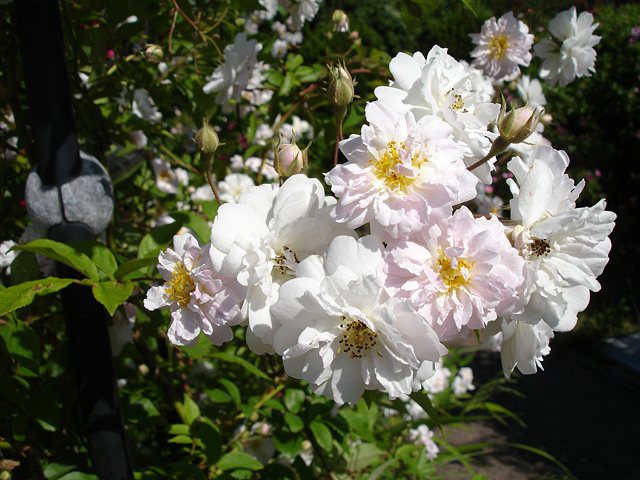

Sanders white rimbler
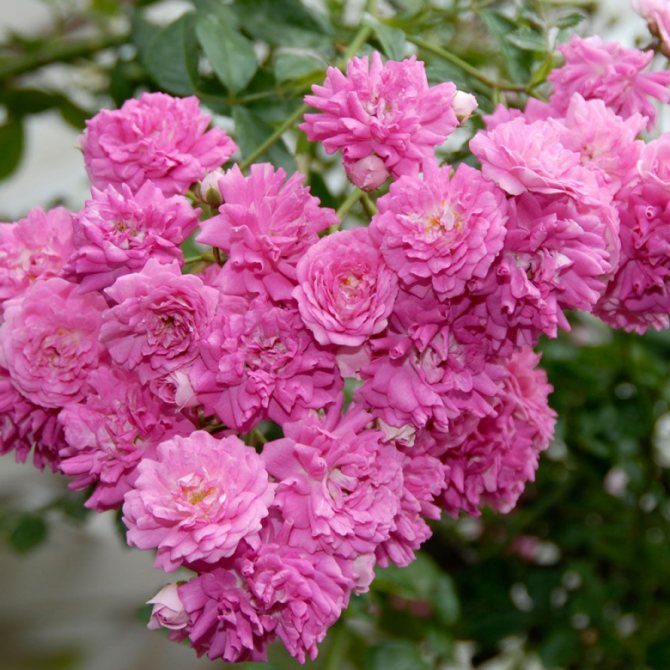

Super dorothy
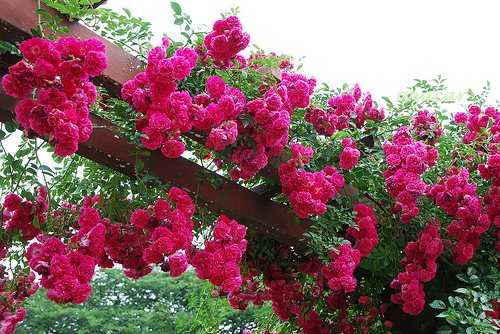

Super Excelsa
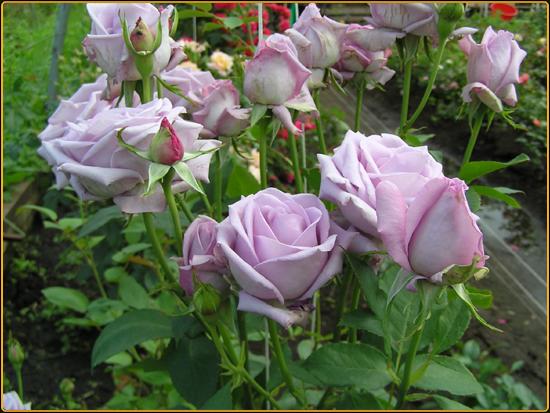

Indigoletta
How to care for climbing roses
The main elements of the care of climbing roses:
- watering - every 10-12 days, 10 liters for each bush;
- mulching cut grass, straw, sawdust, humus;
- soil loosening 2-4 cm deep;
- pruning, removal of faded branches;
- fertilization;
- treatment / prevention diseases, pests;
- shelter for winter.
Fertilization
Caring for climbing roses includes regular fertilization. Plants planted in spring do not need feeding. If desired, in the summer, shrubs can be watered with an infusion of cow dung (1:10 with water) or chicken droppings (1:20 with water). Fertilizer consumption rate - 3-5 liters for each bush. How to feed flowers in the 2nd and in subsequent years of life:
- after removing the winter shelter and after 2 weeks: 1 tbsp. l. ammonium nitrate for each bush, followed by watering;
- during budding (in the middle - late spring): complex fertilizer containing nitrogen (for example, Kemira Lux - 30 g / 1 sq. m.);
- before flowering (early summer): infusion of cow dung (1:10 with water) or chicken manure (1:20 with water), fertilizer consumption rate - 3-5 liters for each bush;
- after 1st flowering (late July - early August): a mixture of 10 g of potassium sulfate and 25 g of superphosphate, diluted in a bucket of water, consumption rate - 3-5 liters for each bush;
- after flowering (late summer - early or mid autumn): superphosphate, consumption - 30 g / 1 sq. m.
For Siberia
In winter, frosts in this area can reach -40 and -50 degrees. The snow cover is uneven: from abundant in Western Siberia to a thin layer in the Eastern part. Gusty winds alternating with snowstorms are typical for long winters. During a short sunny summer, the air temperature can rise up to +40 degrees.
The dry climate is accompanied by a small amount of precipitation - up to 350 mm per year, only in some places reaching 600 mm. In Altai - 1000 mm per year. In some years, rainy summers are offset by early warm springs or golden autumn.
The soils are podzolic and soddy. Low in nutrients, which presents additional difficulties when growing horticultural crops. Necessary conditions for growth: application of mineral, micro - and bacterial fertilizers; weeding; loosening; mulching. Destruction of soils by winds and rains.
For cultivation in Siberia, varieties with high winter-hardy characteristics are suitable. Hardy, quickly adapting to harsh climatic conditions and recovering from winter. With increased formation of shoots to restore frozen ones.
Planting and care will require a lot of labor while waiting for the frozen soil to warm up. Saturation of the soil with a sufficient amount of nitrogen, potash, phosphorus fertilizers in the spring, during the summer and before wintering.
Despite the harsh climatic conditions, rose growers have developed varieties that overwinter and quickly recover.
Mont Blanc
A tall, rosaceous bush with strong, firm branches covered with large glossy leaves. The rich bloom of pink buds in the shape of a bowl or glass is accompanied by a pleasant aroma that is not obtrusive. The flowers reach 12 cm in diameter with a dense arrangement of a large number of petals. Flowering once, long.
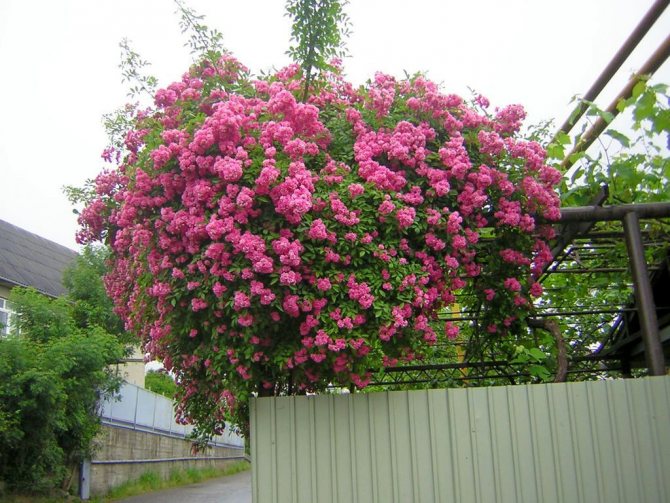

Advantages:
- high frost resistance;
- strong shoots;
- fragrant;
- long flowering.
Disadvantages:
- requires regular pruning;
- one bloom.
The average price of a seedling is 490 rubles.
Lavinia
Pink fluffy buds cover the entire surface of the liana, covering even large enough leaves. Up to 3 m high and about 2 m wide, this climbing beauty will become an elegant decoration of the backyard landscape. Inflorescences are collected in bunches of 7 pcs.
Advantages:
- immunity to disease;
- abundant flowering;
- resistant to rain;
- frost-resistant;
- continuous, long flowering.
Disadvantages:
- average height
.
The average price of a seedling is from 339 rubles. up to RUB 500
Gloria Day
It differs from the rest of the rose flowers in the increased size of the bud. Gradation of color of the petals: from pink at the edges to light yellow in the middle, fading, turns into a monochromatic cream. This distinguishes the variety from fellow tribesmen. The aroma also ranges from light, delicate to sweet-fruity.
Advantages:
- petals do not crumble for a long time;
- high frost resistance;
- unusual color;
- multifaceted aroma;
- abundance of foliage;
- strong shoots;
- immunity to certain types of diseases.
Disadvantages:
- low bush height;
- the aroma depends on the planting site.
Average price of a seedling: 1 years. - 210 rubles, 2 years. - 299 rubles, 3 years. - 320 rubles.
Alchemist
Tall (up to 5.5 m) and voluminous (2.5 m) shrub with the same high characteristics of frost resistance and disease resistance. Its strong stem makes it able to withstand gusty winds. The rapid growth of shoots will ensure the restoration of the decorative appearance in case of their loss in winter.
Bloom in early summer with buds that change color depending on the flowering period and the weather. Initially deep yellow, turning to cream and then to white. The appearance of pink petals in the middle, gaining darker tones, will be an additional bonus of this unusual variety, making it more attractive and justifying the name.
The change in the shape of the bud is also an unusual quality. First, it appears in the form of a glass, then there is a smooth transition to the shape of a bowl, and the final shape is in the form of a rosette. It will be a pleasure to observe this rosaceous exhibit.
Advantages:
- high frost resistance;
- fragrant;
- high immunity to diseases;
- fast growing shoots.
Disadvantages:
- the stiffness of the shoots;
- short flowering;
- small clusters of inflorescences.
Average cost of a seedling: 3 years. - 499 rubles.
New Dawn
A fast-growing sprawling bush with thorny shoots 3–5 m long. The flowers are medium-sized (7–8 cm), slightly double, “loose”, as if airy. Mother-of-pearl buds are collected in brushes of five. As it unfolds, the rose changes its color to creamy pink. The aroma is very bright, fruity. The flowers are suitable for cutting, they fade quickly in the sun. The variety is re-flowering, tolerates partial shade, undemanding to the quality of the substrate.
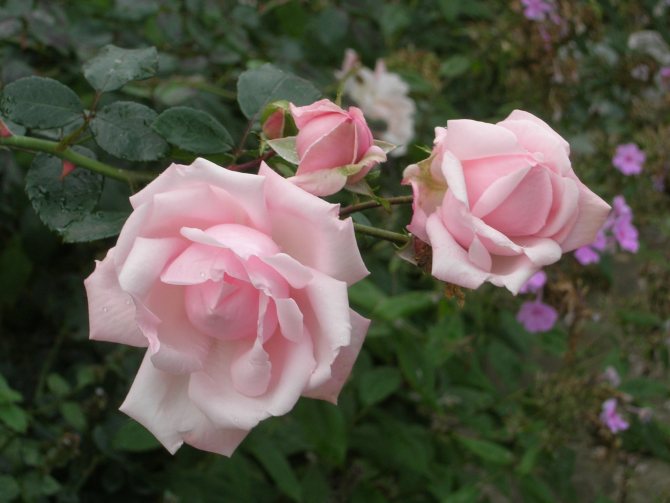

Rose New Dawn was bred in the United States back in 1930, but still successfully withstands competition from new breeding products.
Shelter for the winter
Preparing for wintering and sheltering climbing roses is one of the important elements of flower care. How to do it:
- At the end of August, stop watering, fertilizing the shrub.
- Before the onset of frost, remove the branches from the support, wrap with rope and try to tilt.
- If you feel that the stems may break, fix them in this position. Let the shrub sit for 2-3 days, and then continue until it is completely flat on the ground. Secure with wire or pegs.
- Sprinkle the soil near the trunk circle with fallen leaves or sprinkle with dry earth.
- With the onset of frost, cover the bush with lutrasil. If the winters in the region are cold, overlay the branches with spruce branches, and then wrap with agrofibre.
- In regions with a warm climate, climbing shrubs can be covered with spruce branches, wrapped with burlap, and then with twine, without removing from the supporting structures.


